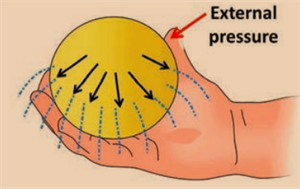PDF chapter test TRY NOW
Pascal's law:
Let us discuss an activity to understand pascal's law.
- Fill a rubber ball halfway with water.
- Using a pin, poke tiny holes in its surface at various spots.
- The following observations can be made when you press the ball.

Pressing the ball
The perforations produce identical streams of water that flow in all directions. This is owing to the fact that the pressure exerted on the liquid is distributed evenly in all directions. Blaise Pascal, a French scientist, was the first to propose this concept.
Pascal's law states that pressure applied at any point in a liquid at rest enclosed in a closed system, will be equally distributed through all regions of the liquid in the closed system.
You can understand this with an experiment involving two syringes connected to each other with a rubber tube.
Fill one of the syringes with liquid and connect them with the rubber tube. Apply pressure to the syringe with liquid by pressing it upwards. The piston in the other syringe will move downwards slightly, and the liquid will start filling inside the other syringe.

Syringes connected with a tube
It is understood that the pressure applied at any point in a liquid enclosed in a closed system, will be equally distributed through all regions of the liquid.
Most important applications of pascal's law:
A hydraulic press (jack) is a device that operates on the principle of pascal's law. It consists of two connected cylinders: one narrow, the other wide. The cylinders are filled with oil. When the piston is pushed into the narrowest cylinder, the pressure in the smaller cylinder is as many times as greater than the pressure in the area of the piston in the larger cylinder. If the area of working piston (S1) is four times greater than the area of the piston in the larger cylinder (S2), then the pressure in the larger cylinder will be quadrapled. Thus, a person can lift the car with one hand jack.

Hydraulic lift
